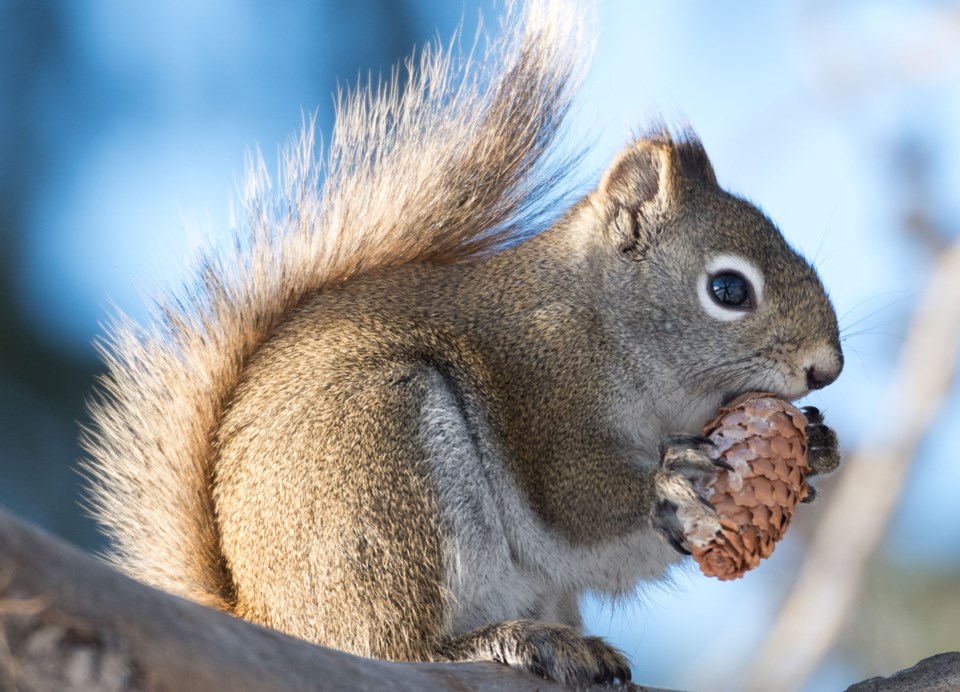Male red squirrels selectively kill young squirrels when there’s plenty of food around, suggests new research from the University of Alberta.
U of A postdoctoral fellow and biologist Jessica Haines published a study this week in Ecology on the first case of sexually selected infanticide in red squirrels.
Red squirrels are found throughout St. Albert and northern Canada.
Haines said she had been studying the effects of food supply on male red squirrels at the Kluane Red Squirrel Project in the Yukon – a remote site near Kluane Lake where researchers tag and track every squirrel in a small area to study long-term trends in behaviour.
In 2014, Haines was doing her usual observations of squirrels at the site when she heard a sudden commotion. Rushing over, she spotted a male red squirrel intruding on the territory of a female caring for a litter of pups.
As she watched, the male ran up and bit one of the female’s pups repeatedly in the neck and abdomen. The female chased the male, causing him to drop the pup, which fell to the ground and died.
“It was fascinating and horrifying and exciting all in one,” Haines said.
Haines later found that the female in question stopped lactating early, suggesting that her whole litter had died. Genetic analysis of the dead pup showed that it had not been fathered by the murderous male, but that the female’s second litter that year was exclusively fathered by him. She also later found a second dead pup with similar injuries, and had previously found pups with chest and neck wounds – wounds consistent with squirrel bites.
Haines concluded that this was evidence of sexually selected infanticide – a practice where males kill the babies fathered by rivals to increase their chances of reproducing with a female. It was the first time that this behaviour had been recorded in red squirrels.
Biologist Stan Boutin, Haines’s supervisor, said he was very surprised by this discovery.
“We’d been following (the squirrels) for a number of years and we thought we’d figured out how the breeding system worked.”
Researchers knew that red squirrels were highly territorial, with females only allowing males to approach them one day out of the year, during which they typically get mobbed by mates, Boutin said.
The exception was “mast” years, when spruce trees produce unusually large amounts of cones for squirrels to eat, Haines said. Females are somehow able to predict mast years and have multiple litters then to take advantage of the food.
Teams at the Kluane site had previously seen unusually high rates of early litter loss during mast years but couldn’t explain it, Boutin said.
These homicidal males may be a contributing factor, Haines said. In most years, the female will only mate once, so males don’t have an incentive to be baby killers. Mast years give them a second chance, which makes murder an option.
“It’s certainly not a good story from the female’s perspective,” Haines said, or to the first male, but it’s a great deal for the murderer.
Haines said it was unusual to see this practice in a territorial species like red squirrels. Most species that practice sex-selected infanticide tend to have shared territories where males can monopolize access to females. The territorial nature of red squirrels makes this impossible, so females typically have multiple mates.
This practice makes evolutionary sense, and makes for a literal battle of the sexes, Boutin said. Still, it’s tough to say how many of our local squirrels might have homicides on their rap sheets.
“If you follow through the years and you see that it’s a year where all the spruce and pine trees have high numbers of cones on them, you know that probably at least some of these guys are very, very guilty.”




